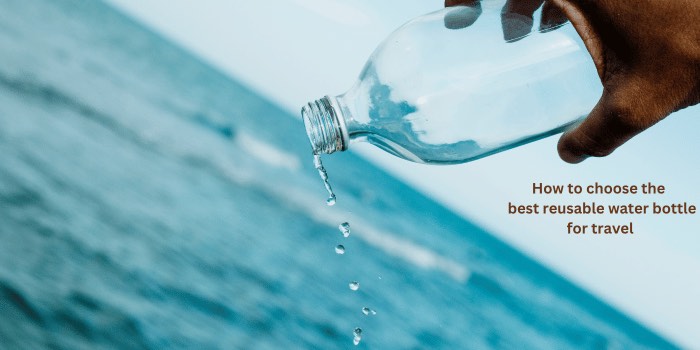Has your search for the best reusable water bottle for travel resulted in a cupboard cluttered with countless varieties? After years of searching for the best travel water bottle, I’ve concluded that it doesn’t exist. No ONE water bottle works for every destination and type of adventure. However, I’ve found FOUR, one or two of which are packed for every trip.
What about you? Is there a favourite water bottle that has earned a permanent place in your travel bag? If so, congratulations (and please share this breakthrough with others in the comments). If you’re still on the hunt, hopefully the following features and suggestions will be helpful.
Table of Contents
The importance of a reusable water bottle
Travelling with a trusty, reusable water bottle is a savvy, sustainable choice.
- Remaining hydrated with safe drinking water is a healthy way to travel.
- When a reusable water bottle is always with you, staying quenched and hydrated becomes a convenient and effortless part of your day.
- Buying water is expensive; it saves money for spending where it counts.
- In most countries, bottled water is just as good as tap water.
- It saves time searching for a reliable water source.
- It’s an eco-conscious choice to reduce your carbon footprint by not contributing to the scourge of single-use plastic bottles that end up as plastic waste in oceans and landfills.
Factors to consider when choosing a reusable water bottle for travel
When shopping for a reusable water bottle, consider how you will carry it and the type of functionality and features you require. Consider factors such as material, insulation, lid and cap style, leakproof design, weight, shape, size, portability, durability, preferred mouth opening, ease of cleaning, and any other factors that are important to you. These will help you make the best choice for your different travel scenarios.
1. Material
(i) Plastic
Plastic bottles are popular because they’re lightweight, versatile, and affordable. However, their longevity is questionable, and they can eventually develop an unpleasant odour. For health reasons, always look for ones free of the industrial chemical Bisphenol A (BPA-free).
(ii) Stainless steel
Single-walled stainless-steel bottles are lightweight (usually a little heavier than plastic), durable, and affordable. While they’re susceptible to dents when dropped, they don’t break like glass or crack like plastic. They pose no known health risks and are dishwasher safe. Considering their lifespan of many years, they represent superb value. Some bottles have an impact buffer on the bottom to protect them from dents.
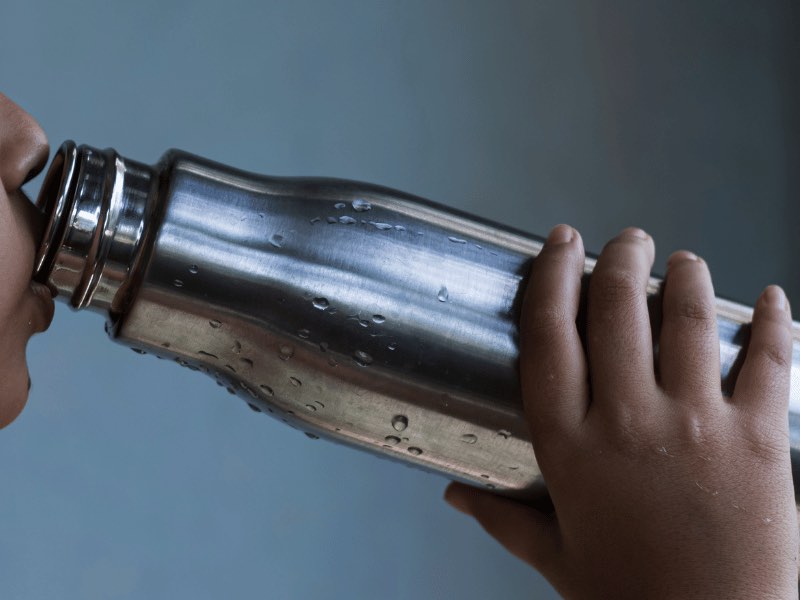
(iii) Glass
Glass bottles are dishwasher safe, pose no known health risks, and offer a pure taste experience. However, they demand more care to avoid breakages, so are suited to more sedentary pursuits than travel. However, breakages can be minimized when a bottle is encased in a protective sleeve.
2. Insulation
If you don’t enjoy drinking lukewarm water, an insulated stainless-steel bottle might be for you. An insulated bottle can maintain a supply of cold water or keep hot drinks hot for chilly adventures. They’re highly durable because their double-wall construction gives them added protection against damage. However, the insulation comes at a cost, weighing more than non-insulated versions. Popular brands include Hydro Flask, Thermos, and Yeti.
3. Weight
Every ounce or gram counts when you must carry it for long periods. How much weight can you tolerate in a water bottle? How much water will it carry? Keep in mind a litre (34 fl oz) of water weighs a kg (2.2 lb), and 750 ml (25 fl oz) weighs 750 g (1.65 lb).
4. Shape
Do you need it to fit snugly in your hand, backpack, purse, waistband loop, running belt, bicycle cage, or a cup holder in a vehicle? Some collapsible or rectangular bottles don’t fit in a standard bicycle cage or vehicle cup holder. Some bottles are too tall and top-heavy to remain secure in a backpack pocket or fit under a tap or the outlet in a dispensing machine. Some are too wide for a side pocket of a day bag or backpack. The shape needs to be compatible with how you plan to carry it.
5. Wide mouth or narrow mouth (or both)
A wide-mouth bottle is easier to fill or add ice cubes. A narrow-mouth bottle means less likelihood of getting splashed while drinking, especially while walking or in a moving vehicle. A wide-mouth bottle is easier to clean and air-dry. Some bottles, like the Yeti Yonder, boast both features.
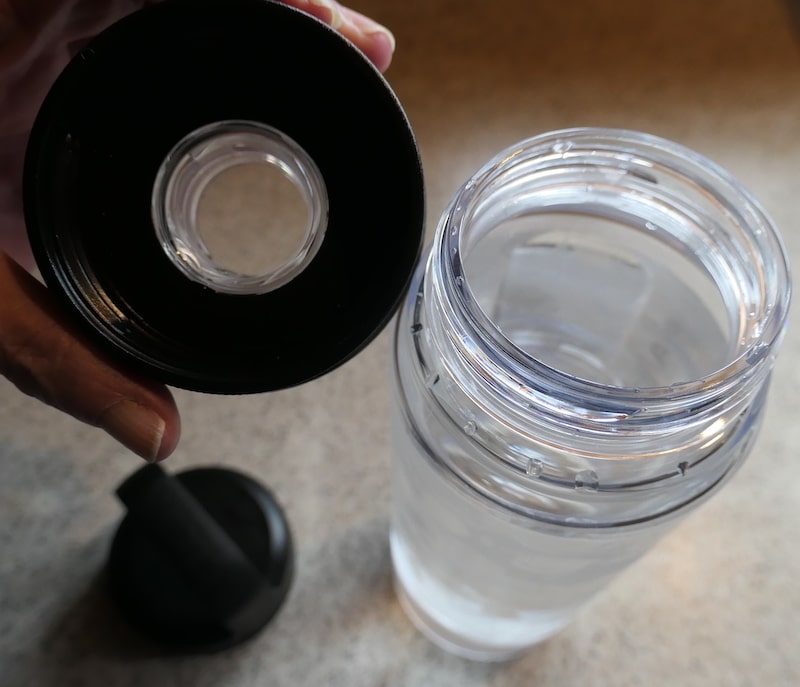
6. Lid and cap style
(i) Twist-off
These caps are a solid classic, often offering a wide mouth for easy refills from any water source. Still, they typically require two hands to use them. Make sure the grooves and ridges are wide enough apart so gunk doesn’t gather in the tracks and is difficult to remove.
(ii) Flip-top straw
These bottles offer quick access with one hand, ideal when juggling other items. Their ‘but’ factors are that they’re more challenging to clean and don’t do well under pressure. Flip one open at 30,000 feet, and you’ll spray yourself and nearby passengers with a shower of bottled water.
(iii) Leakproof
Not every reusable water bottle has a leakproof seal. Sometimes, a water bottle comes in close contact with valuable electronics, and an unexpected leak or spill can be very costly. You’ll want a cap that seals tightly every time. Check reviews to see if any travellers have experienced leakages with the product you’re thinking of buying.
(iv) Attachment point
Many water bottles have a handle that’s part of the lid, a tether so the top remains attached to the bottle, or a grommet to insert a carabiner. An attachment point lets you clip your water bottle to a purse or bag for easy access.
7. Size and Portability
A one-litre bottle might meet your hydration needs for a day on the trail, but the extra weight may not be worth it for an urban adventure with access to safe refilling stations. Portability is also essential. Will it be carried in a pocket, purse, backpack, or sling?
Also, if an empty water bottle feels like dead weight that takes up too much space, perhaps a lightweight, collapsible bottle deserves a place in your travel bag.
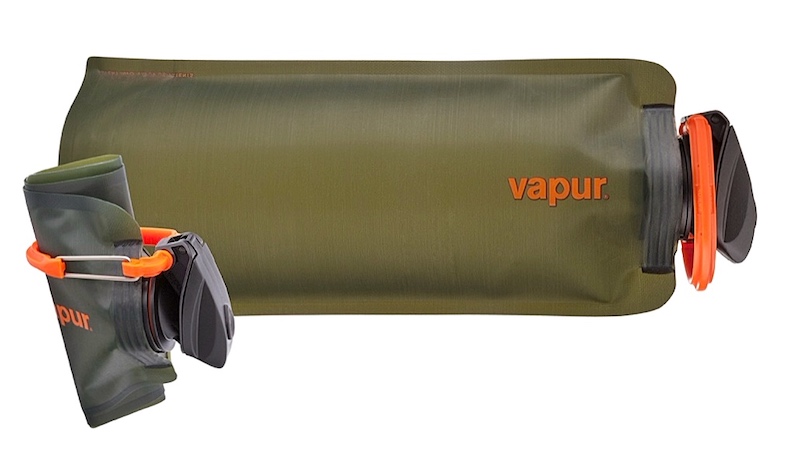
8. Durability
A water bottle needs to withstand the rigours of travel. Stainless steel options are tough and long-lasting; they can usually handle being dropped or scraped against rocks while hiking. They may dent, but their functionality is maintained.
Plastic might be lightweight, but it doesn’t hold up well over time, leading to leaks and cracks that no traveller wants to deal with while on the move.
If you favour glass, look for one with a protective sleeve without adding much weight.
9. Easy to clean
To ensure your water bottle stays clean and hygienic, opt for a design with a wide mouth or removable parts capable of being easily cleaned without specialized tools. Glass and stainless-steel bottles are dishwasher-safe. Some plastic bottles are rated as dishwasher safe by the manufacturer, but most travellers don’t have access to a dishwashing machine.
Consider travelling with sterilizing tablets designed for cleaning water bottles.
Will you be using hydration tablets or powders? If so, opt for an easy-to-clean bottle that can be cleaned daily.
10. Filtration and sterilization
For travel to areas with limited access to clean water, look for a water bottle with unique features like built-in filtration or sterilization capabilities.
Popular brands with a water filter include Brita, Grayl, Hydro Flask, LARQ, and LifeStraw. A standout is the Grayl GeoPress that filters particulates such as silt and microplastics, and absorbs chemicals, pesticides, and heavy metals. It also absorbs waterborne pathogens (99.99% of viruses, 99.9999% of bacteria, and 99.9% of protozoan cysts), including Rotavirus, Hepatitis A, Norovirus, Giardiasis, E. Coli, Cholera, Salmonella, Dysentery, and many more. Another outstanding feature of the GeoPress is the optional add-on one-way drink mix valve for adding an electrolyte tablet or powder into freshly filtered water without clogging the filter.
Top brands that use the sterilizing properties of UV-C technology are CrazyCap and LARQ. Both manufacturers produce a bottle with a self-cleaning function. Unlike water bottles with filters, they don’t get rid of dirt and sediments found in water from natural sources. They kill bacteria, viruses, protozoa, and other microorganisms by destroying their DNA.
My top picks for the best reusable water bottle for travel
After years of accumulating an extensive collection of reusable water bottles, these are the top picks that work for me and my travels. Your choices may be similar or entirely different.
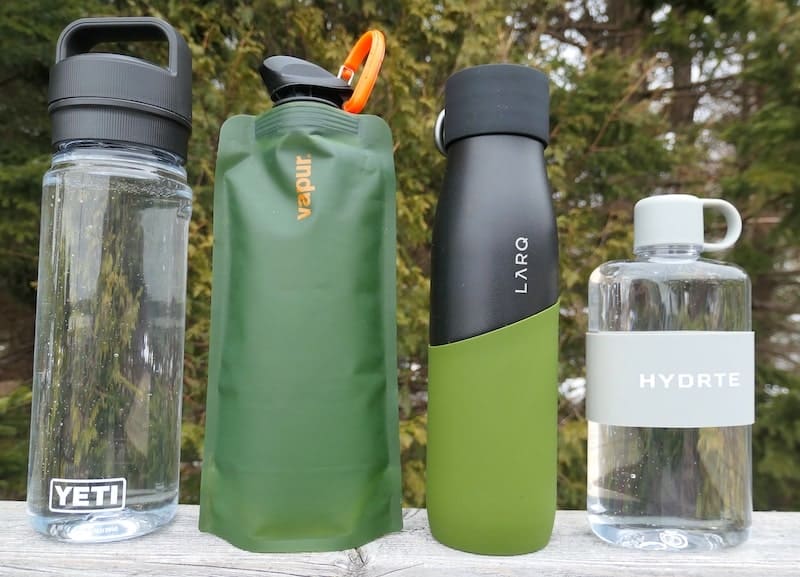
1. LARQ Bottle Movement Pure Vis
LARQ uses UV technology to provide on-the-go water purification and a self-cleaning function. It has three cleaning and sterilization modes: normal, adventure, and travel. LARQ claims that the sterilization process in adventure mode is the equivalent of boiling water for 20 minutes. It eradicates biological contaminants in water from both safe and questionable sources by destroying their DNA, rendering them harmless. It eliminates up to 99.9999% of bacteria and 99.99% of viruses in adventure mode. The LARQ Bottle Movement Pure Vis is my water bottle of choice when travelling to areas without safe and reliable sources of clean drinking water. For my detailed review, see Is the LARQ bottle worth it?
2. Yeti Yonder
The Texas-based manufacturer, Yeti, has a loyal following. The Yeti Yonder is one of its more lightweight products – a tall, cylindrical bottle with a capacity of 750 ml (25 fl oz). Its standout feature is the Chug Cap, a two-in-one cap that creates both narrow and wide-mouth openings for drinking, filling, and cleaning. Its shatter-resistant, BPA-free plastic is rated as dishwasher-safe. However, it’s built to be cleaned easily without valves, straws, or difficult-to-reach places.
It’s 11.1 in (28 cm) tall and 3.1 in (8 cm) in diameter. The lid is leakproof and has a built-in ‘clippable’ bar as a solid attachment point. Empty, it weighs 9.6 oz (273 g). It’s heavy at 2 lb 5.6 oz or 1,066 g when filled.
3. Hydrte Slim
My Hydrte is a slim, sleek, and compact option that’s perfect for sightseeing. Its flat, flask-like design means it can slip into a pocket of my travel vest, the inside pocket of my purse, or a side pocket of my day pack. The built-in loop is part of the cap, offering the option to insert a carabiner to attach it to something else. Measuring 3.5 x 3.5 x 7.5 in (9 x 9 x 19 cm) and weighing 3.7 oz (105 g), it’s an ideal choice for situations where other opportunities for remaining hydrated are readily available. I use it in cities with refilling stations offering safe drinking water. When filled (500 ml or 17 fl oz), it’s a weight I can easily tolerate (575 g or 20 oz). I like the narrow mouth for drinking, but it’s more challenging to clean and takes longer than wide-mouth bottles to air-dry. It’s not dishwasher safe.
4. Vapur Eclipse Flexible
The Vapur Eclipse is a collapsible, packable water bottle favourite of many minimalist carry-on travellers. My 0.7 l (23 fl oz) bottle weighs just 1.3 oz (38 g) and it’s made of BPA-free polyethylene and nylon. It’s rated as dishwasher safe, but I have greater confidence in a bottlebrush to clean the difficult-to-reach places. The wide mouth opening makes it easy to fill, and the flip cap reveals a small spout for drinking. Lack of rigidity makes it difficult to drink with one hand, but its packability makes up for it. While it’s rated to hold 700 ml, 500 ml (17 fl oz) is acceptable when there’s access to filling stations and other opportunities to remain hydrated. With 500 ml, it weighs 17.3 oz (491 g), a manageable weight. Its flexibility means I can squeeze the sides at the bottom together so it fits in a side pocket of my day pack or a round cup holder in a vehicle. It’s a lightweight companion to my LARQ bottle for transferring sterilized water from the LARQ to the much lighter Vapur Eclipse. When empty, the bottle is easily rolled, and the carabiner on the cap creates a compact, packable package. When carrying water, the carabiner makes it easy to connect the Vapur to an attachment point.
Maintenance and care tips
According to Water Filter Guru, reusable water bottles host as many as 40,000 times more bacteria than the average toilet seat, twice as many germs as the kitchen sink, four times the bacteria as a computer mouse, and 14 times more than a pet’s drinking bowl.
Bacteria transfer from a person’s mouth with every sip. These then multiply inside the bottle, exacerbated by the fact that bacteria flourish in a moist environment. Adding a hot climate and a reusable water bottle can be a liability without a strategy to keep it clean.
Ideally, a bottle should be cleaned after each use. Some are rated as dishwasher safe, but most can be cleaned with warm water, dish detergent, and a bottle brush. Not all travellers have these readily available. And some bottles are more difficult to clean than others. Straw bottles, screw tops, and collapsible bottles present their unique challenges in keeping the crevices and hard-to-reach places clean and free of bacteria.
To keep your reusable water bottle clean and functional throughout your trip, consider these care tips:
1. Carry sterilizing tablets
Use sterilizing tablets specifically designed for cleaning water bottles. Follow the instructions of the manufacturer. I use Clean Hike with each tablet in individual packaging to maintain effectiveness. In the past, I’ve used individually wrapped denture cleaning tablets from a dollar store. Both contain Sodium bicarbonate (baking soda).
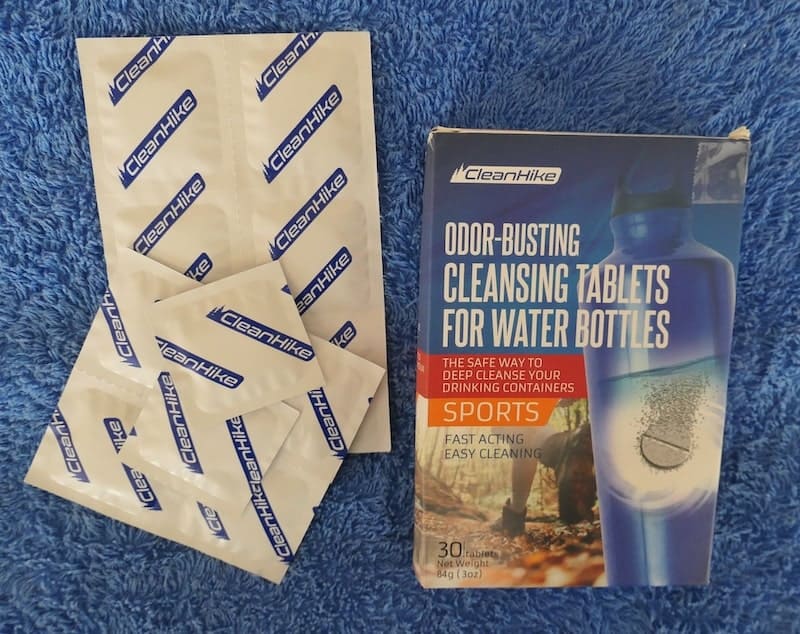
2. Wash and rinse
Regularly wash your bottle with warm, soapy water and thoroughly rinse it to remove any soap residue.
3. Use a dishwasher or bottlebrush
If your bottle is rated as dishwasher-safe, this is an option when a dishwasher is available. Otherwise, where possible, use a bottle brush to scrub the inside of the cap, the bottle, and the ridges and grooves where the lid screws onto the bottle. Pay special attention to hard-to-reach areas to prevent bacteria buildup. If you’re travelling long-term, consider packing a portable water bottle cleaning set. Check out the Oxo Good Grips Water Bottle Cleaning Set. It’s dishwasher-safe with a large bottle brush, a skinny straw brush, and a looped, detail-cleaning brush, all kept together on a handy ring to avoid losing parts.
4. Use baking soda or vinegar
For unpleasant odours, try a solution of baking soda and water and let it sit in the bottle for a few hours before rinsing thoroughly. If the smell persists, try a solution of equal parts vinegar and water. If that doesn’t work, discard the bottle.
5. Air dry
Back home, allow the bottle to air dry before storing it away.
Conclusion
Staying hydrated is critical to a healthy, enjoyable day of exploring. Finding the right reusable water bottle is a challenge, and it can get expensive without a clear idea of the features you need for your various travel scenarios.
If you found this post helpful, please share it by selecting one or more social media buttons. In your experience, what is the best reusable water bottle for travel? Do you have one or more favourites? Please share your thoughts in the comments. Thank you.
Care to pin it for later?
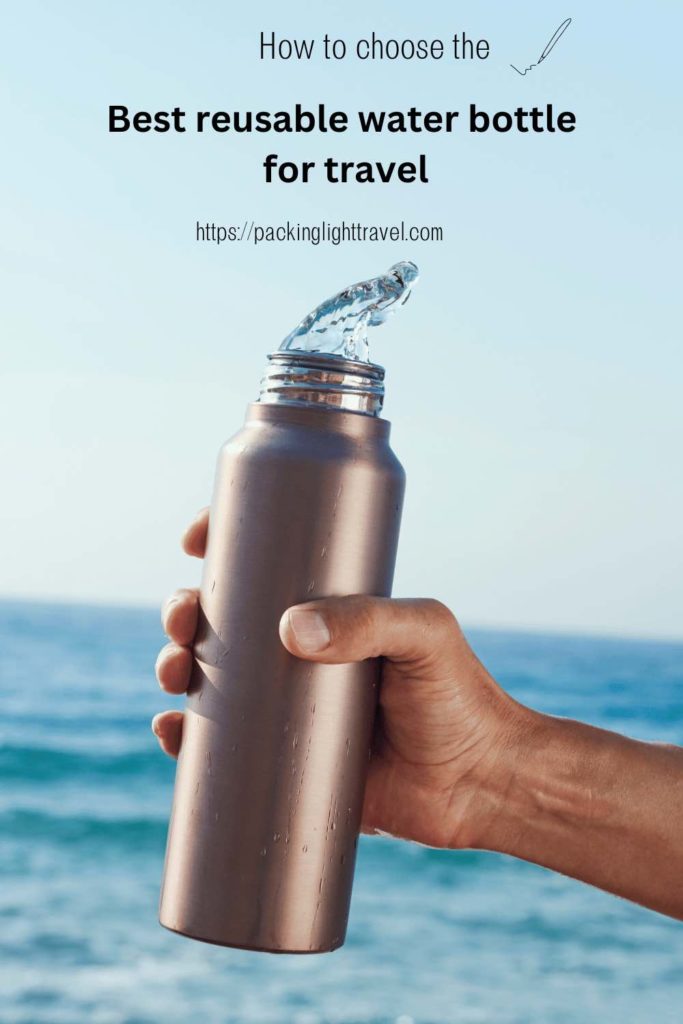
The Amazon links in this post are affiliate links. If you click on one and purchase something, you don’t pay more but Packing Light Travel earns a small commission which helps with the costs of maintaining the site. Thank you for your support.

